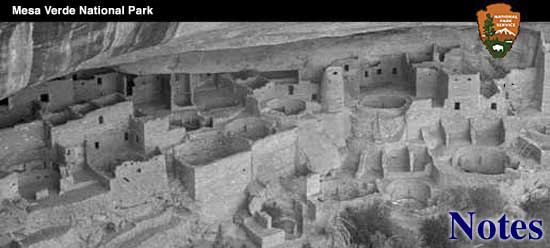

|
The largest and most beautiful lizard found in Mesa Verde National Park is called the Collared Lizard (Crotaphytus collaris). The Mountain Boomer, as he is sometimes called, is easily distinguished from other lizards by his green color and by the fact that adult specimens often attain a length of 30 centimeters (12 inches). The range of the Collared Lizard in Colorado includes the southern counties of the state, on both sides of the Continental Divide. In the Mesa Verde he may be found in the bottoms of the canons, on their deep rocky sides, and on the flat top of the mesa itself. The economic value of this lizard, as far as destruction of injurious insects is concerned, is not to be questioned. However, the fact that he enjoys on his bill of fare any small lizard that may chance to cross his path nearly nullifies his value as an insect eater. In a park such as Mesa Verde, where wild life is encouraged and protected, it would be unwise to let the numbers of the Collared Lizard increase to any great extend. A few specimens here and there through the park are sufficient to illustrate this type of wild life. The bright green color, which has been mentioned as the distinguishing mark of this lizard, varies from a bright blue-green to a slate-gray, depending on the season and somewhat on the locality. In the breeding season the males are usually the more highly colored, having bright red or orange around the head and throat. Specimens taken from the dark brown rocks in McElmo Canon, a few miles west of the Mesa Verde, appeared to be a darker green. Other specimens found among the white rocks near Canon City, Colorado, are a very light grey-green in color. The Collared Lizard, in common with many other species in Colorado, while not changing color rapidly as does the Chamelion, tends to shade in his coloration toward the color of his surroundings. One exceptionally fine specimen has made his home about one hundred yards back of the Park Museum. This particular lizard proved to be so tame a photograph of him could be made with a portrait lens at a distance of thirty inches. While most individuals of this species seem very tame when approached by humans, it is not advisable to capture them with bare hands. An examination of the broad head, powerful jaw muscles, and sharp teeth will show that these lizards can inflict a painful wound easily piercing or tearing the skin. The Collared Lizard, in common with all Colorado lizards, is not poisonous. -oOo- THE UTAS. Very interesting reptiles of Mesa Verde are the two Utas: Stansbury's Uta (Uta stansburiana stansburiana), and Uta levis. As there is no accepted common name for the latter species, the scientific name, Uta Levis, has been used throughout this article. These two lizards both have a dark brown or dark gray ground color and are the only two species so colored and found living among rocks in the park, whose scales are not keeled and sharply pointed, as are the scales of the two Scelopori discussed in Volume III, Number 1, of Mesa Verde Notes. These lizards are further characterized by the fact that they never grow over 15 centimeters (6 inches) in length and that the head is broad and very flat. Uta Levis is far the more common in the Mesa Verde. This species may be seen at any time, on sunny days, halfway down the trail to Spruce Tree House ruin, just below the Community Building. They are very much the same color as the rocks on which they are found darting back and forth in search of spiders and small flies, or lying flat on the rock surface, taking a sun bath. Stansbury's Uta is not common around Park Headquarters. He may be seen on the rocks along the Soda Tip-off trail, along the southern end of Chapin Mesa. It is rather difficult for one who is not familiar with both species of Utas to distinguish between them at any distance. At close range, however, a decided difference is apparent. Uta levis has a number of rows of enlarged scales down the middle of the back, the scales to these rows being decidedly larger than those of the adjoining rows. The scales on the back of Stansbury's Uta are all much the same in size, there being no rows of enlarged scales down the center of the dorsal region. As a rule Uta levis is darker in color, generally having a dark gray-ground cross-band on the back with light markings. Stansbury's Uta is generally a light brown, often with a reddish cast with no cross markings on the back. -oOo- | ||||||
| <<< Previous | > Cover < | Next >>> |
vol3-2d.htm
14-Oct-2011